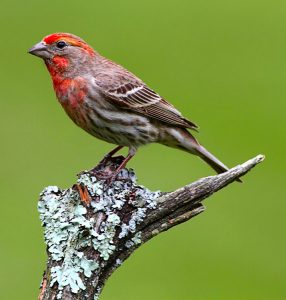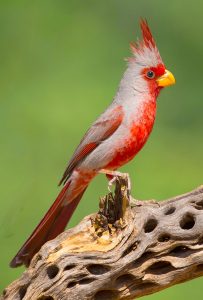Some days, you need a little help to make you smile. Life is busy. We all get mired in routines and requirements that can drag us down if they go on too long. That’s one of the reasons we love bird feeding so much: it’s a stress-free and low maintenance way to break us out of that daily grind and remind us to connect with the life around us. And what’s more lively than a spark of bright red outside the window? If you’re wondering what that eye-catching avian is, Harvest can help.
 Northern Cardinals are the #1 most popular backyard bird in America. Their spiky crests, bright orange beaks, and long tails are easy to spot, and the males’ vivid red plumage has made them a classic image for winter holiday cards across the country — even in regions where the birds themselves don’t live! Common from the Midwest to the Eastern USA, these red beauties can be found in backyards near forests or parklands where they prefer to forage on the ground, often in pairs. The female Cardinal’s feathers are more muted than her brilliant mate’s, but she still sports her share of red highlights in her wings and crest. You can attract these beautiful birds to your yard by planting low shrubs which provide a protected place to roost. Keep them coming back by stocking your feeders with their favorite black oil sunflower seeds.
Northern Cardinals are the #1 most popular backyard bird in America. Their spiky crests, bright orange beaks, and long tails are easy to spot, and the males’ vivid red plumage has made them a classic image for winter holiday cards across the country — even in regions where the birds themselves don’t live! Common from the Midwest to the Eastern USA, these red beauties can be found in backyards near forests or parklands where they prefer to forage on the ground, often in pairs. The female Cardinal’s feathers are more muted than her brilliant mate’s, but she still sports her share of red highlights in her wings and crest. You can attract these beautiful birds to your yard by planting low shrubs which provide a protected place to roost. Keep them coming back by stocking your feeders with their favorite black oil sunflower seeds.
 Grosbeaks are songbirds in the Finch family. As their name suggests, they have enormous beaks that they use to crush seeds. There are two species of Grosbeaks with red feathers. Pine Grosbeaks are medium-sized round birds whose males have muted red feathers that blend into grey. While they are primarily northern forest birds, they are readily attracted to feeders with suet or a treat of fresh fruit.
Grosbeaks are songbirds in the Finch family. As their name suggests, they have enormous beaks that they use to crush seeds. There are two species of Grosbeaks with red feathers. Pine Grosbeaks are medium-sized round birds whose males have muted red feathers that blend into grey. While they are primarily northern forest birds, they are readily attracted to feeders with suet or a treat of fresh fruit.
Rose-breasted Grosbeak males are black and white birds with shockingly red chests. They range from the midwest to the eastern US and can often be seen at forest edges where they typically nest in sapling trees. These charmers are particularly beloved of birders and will happily visit platform or tube feeders where they can snack on sunflower seeds and raw peanuts.
 House Finches and Purple Finches are smaller songbirds which both have red-toned plumage. House Finches can be seen over most of the US where they can be found in neighborhoods and parks. House Finches get their color from the food they eat — they can range from bright red to orange or even yellow depending on their diet. Female House Finches actually look for the brightest males in the hopes that they will provide the most food during nesting season!
House Finches and Purple Finches are smaller songbirds which both have red-toned plumage. House Finches can be seen over most of the US where they can be found in neighborhoods and parks. House Finches get their color from the food they eat — they can range from bright red to orange or even yellow depending on their diet. Female House Finches actually look for the brightest males in the hopes that they will provide the most food during nesting season!
Purple Finches are more ‘raspberry’ colored than purple. They range from the East Coast to the Pacific Northwest and can often be heard in the tops of trees where they not only sing their own song but also are able to mimic the calls of other birds. You can attract Purple Finches by providing plenty of their favorite black oil sunflower seed.
 Pyrrhuloxias are often mistaken for female Northern Cardinals with their red crests and short, stubby bills. (You can spot the difference in their faces: a Pyrrhuloxia’s beak is yellow where a Cardinal’s is orange.) They are native to the more arid regions of the Southwest, where they can be found perching on cacti or foraging in low desert shrubs. If you live in the Southwest you can attract these lovely birds to your feeders by providing platform feeders with a variety of seeds — preferably placed in the shade! Encourage Pyrrhuloxias and other backyard birds to visit by offering a birdbath for a cool spot to rehydrate.
Pyrrhuloxias are often mistaken for female Northern Cardinals with their red crests and short, stubby bills. (You can spot the difference in their faces: a Pyrrhuloxia’s beak is yellow where a Cardinal’s is orange.) They are native to the more arid regions of the Southwest, where they can be found perching on cacti or foraging in low desert shrubs. If you live in the Southwest you can attract these lovely birds to your feeders by providing platform feeders with a variety of seeds — preferably placed in the shade! Encourage Pyrrhuloxias and other backyard birds to visit by offering a birdbath for a cool spot to rehydrate.
No matter where you live, there is probably a species of red bird native to your area. By providing food, water and a place for birds to perch you can encourage these beauties to come and brighten your yard with a visit. If you’re lucky they will bring a friend or two for a flock of brilliant color!

